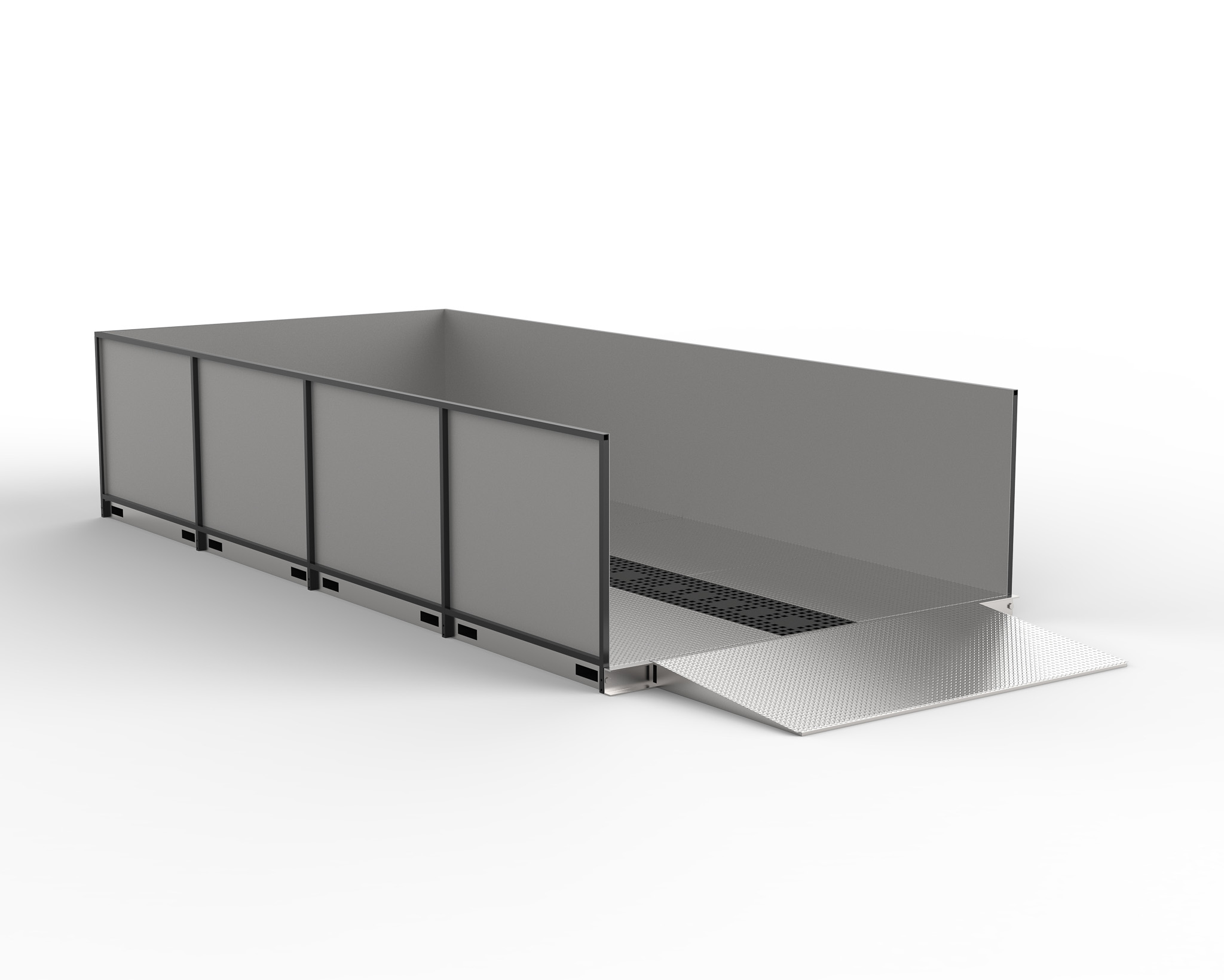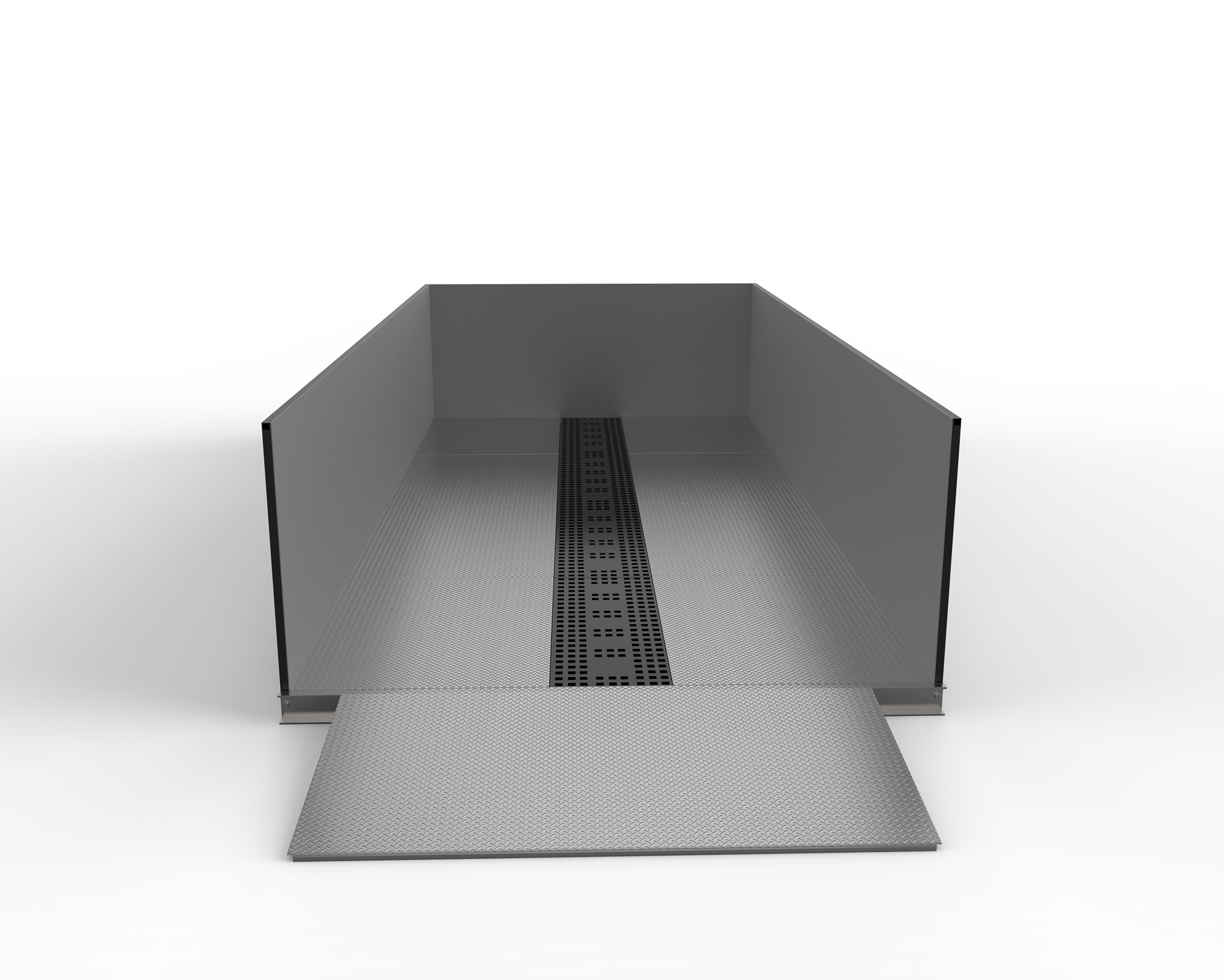WASH RACK DESIGN
WASH RACK DESIGN SHOULD CONSIDER WORK AREA, SOLIDS VOLUME, VEHICLE SIZE, AND WASHING FREQUENCY
WASH RACK DESIGN
WASH RACK DESIGN SHOULD CONSIDER WORK AREA, SOLIDS VOLUME, VEHICLE SIZE, AND WASHING FREQUENCY
Wash Rack Design: steel above-ground wash-rack or concrete in-ground racks?
Choose between steel above-ground wash-rack or concrete in-ground racks. Each type serves different purposes depending on your specific needs. If you need something semi-permanent, the steel racks are right for you.
Choose concrete if you want a rack that is permanent and more heavy-duty. No matter which type works best, you can customize the racks to your size and wash load specifications.
Designs tailored to your needs can be multi-stage wash and rinse systems for the phosphate pretreatment industry, salt removal systems for corrosion control applications, automated rinse systems for conveyor lines, or extreme environment installations.
Above Ground Wash-Rack or Permanent Wash Pad
A steel wash-rack gives you flexibility in a semi-permanent containment system that is built to your specs or to your site requirements. Steel above ground containment rack systems make installing a wash rack easier than ever.
With no permitting required, this bolt-together system can be installed in a matter of hours, and sized to your exact requirements, plus there is the option to expand later. The above-ground wash racks are ideal for applications where property is leased, such as oil or gas exploration, and where the operator must meet track-out requirements without incurring leasehold improvements.
If you intend to move your wash rack within your facility, or if you don’t have the inclination to work through the permit process for an in-ground wash pad, steel wash racks are ideal.
Above-ground wash rack designs are manufactured in various length and width increments and can be designed to carry loads up to 12,000 lbs. per wheel. These can also be low profile racks which make it easy to even get low clearance man-lifts and forklifts onto the racks for washing.
In addition to being easier to get onto, low-profile racks are safer for your equipment and employees. The solid diamond-tread plate decks are coated with grit-impregnated epoxy paint to give a sure grip even when wet and soapy.
When specifying a truck wash rack, there are several key factors to consider to ensure that you select the best solution for your specific needs. These considerations include the size and type of vehicles to be washed, the frequency of use, the available space, environmental regulations, and budget. Let’s delve into each of these factors in more detail, along with some additional technical specifications to keep in mind.
Vehicle size and type:
• Determine the dimensions of the largest vehicles that will be washed on the rack, including length, width, and height.
• Consider the types of vehicles (e.g., trucks, buses, military vehicles) and their specific cleaning requirements.
• Ensure that the wash rack is compatible with the vehicles’ materials and components to avoid damage during the cleaning process.
Frequency of use:
• Estimate how often the truck wash rack will be used daily, weekly, or monthly.
• Higher usage frequency may require a more durable and efficient system to withstand the increased wear and tear.
• Consider the peak hours of operation and ensure that the wash rack can handle the expected volume of vehicles during those times.
Available space:
• Measure the available space for the truck wash rack installation, including the washing area, equipment storage, and water treatment facilities.
• Consider the layout and traffic flow of the site for your wash rack desgn to ensure that vehicles can easily enter, exit, and maneuver within the wash area.
• Plan for future expansion or upgrades, if necessary, and ensure that the chosen wash rack system can accommodate these changes.
Environmental regulations:
• Familiarize yourself with local, state, and federal environmental regulations regarding wastewater treatment and discharge.
• Choose a wash rack system that incorporates appropriate water treatment and recycling technologies to minimize water consumption and comply with regulations.
• Consider the use of environmentally friendly cleaning agents and ensure that the wash rack is compatible with these products.
Water usage and conservation:
• Evaluate the water usage efficiency of the truck wash rack system, as this can significantly impact operating costs and environmental footprint.
• Look for features such as high-pressure, low-volume nozzles, and water recycling systems that can reduce water consumption without compromising cleaning performance.
• Consider the availability and cost of water in your location and factor this into your decision-making process.
Cleaning performance and efficiency:
• Assess the cleaning capabilities of the truck wash rack system, including its ability to remove dirt, grime, and other contaminants specific to your vehicles.
• Look for features such as adjustable water pressure, multiple nozzle configurations, and specialized cleaning attachments that can enhance cleaning performance and efficiency.
• Consider the use of automated or semi-automated systems that can reduce labor costs and improve consistency in cleaning results.
Ease of use and maintenance:
• Evaluate the user-friendliness of the truck wash rack system, including the controls, settings, and overall operation.
• Consider the level of training required for operators and the availability of technical support from the manufacturer.
• Assess the maintenance requirements of the system, including regular cleaning, inspection, and replacement of components, and factor these costs into your budget.
Durability and longevity:
• Investigate the quality of materials and construction used in the truck wash rack system to ensure long-term durability and reliability.
• Look for features such as corrosion-resistant components, heavy-duty frames, and reinforced surfaces that can withstand the rigors of frequent use and exposure to harsh cleaning agents.
• Consider the manufacturer’s warranty and reputation for producing high-quality, long-lasting products.
Safety features:
• Prioritize the safety of operators and vehicles during the washing process by selecting a wash rack system with appropriate safety features.
• Look for non-slip surfaces, emergency shut-off switches, and proper drainage to minimize the risk of accidents and injuries.
• Ensure that the wash rack complies with relevant safety regulations and standards, such as OSHA requirements.
Budget and cost-effectiveness:
• Determine your budget for the initial purchase, installation, and ongoing maintenance of the truck wash rack system.
• Consider the long-term cost-effectiveness of the system, taking into account factors such as water and energy efficiency, durability, and maintenance costs.
• Compare the features and benefits of different truck wash rack options within your budget range to find the best value for your investment.
Integration with existing infrastructure:
• Evaluate how well the truck wash rack system integrates with your existing infrastructure, such as water supply, drainage, and electrical systems.
• Consider any necessary modifications or upgrades to your facility to accommodate your wash rack design and operation.
• Work with the manufacturer or a qualified contractor to ensure a smooth and efficient integration process.
Customization options:
• Assess your specific cleaning needs and look for a truck wash rack system that offers customization options to meet those requirements.
• Consider features such as adjustable nozzle configurations, specialized cleaning attachments, and programmable wash cycles that can be tailored to your vehicles and cleaning standards.
• Discuss your customization needs with the manufacturer to ensure that the wash rack system can be adapted to your unique circumstances.
Manufacturer support and reputation:
• Research the reputation and experience of the truck wash rack manufacturer to ensure that you are working with a reliable and knowledgeable company.
• Look for manufacturers with a proven track record of producing high-quality, durable, and efficient wash rack systems.
• Consider the level of customer support and technical assistance the manufacturer provides, including installation guidance, training resources, and ongoing maintenance support.
Wall heights and drive-in or drive-through configuration:
• Determine the appropriate wall heights for your wash rack design on the size of the vehicles to be washed and any local building codes or regulations.
• Decide whether a drive-in or drive-through configuration suits your needs, considering available space, traffic flow, and cleaning efficiency.
• Ensure that the chosen configuration allows for easy access and egress of vehicles and provides adequate containment of water and cleaning agents.
Steel thickness, load-bearing capacity, and paint coating:
• Specify the appropriate steel thickness and load-bearing capacity for the truck wash rack components, such as the walls, floor, and any supporting structures.
• Ensure that the steel is adequately coated with a durable, corrosion-resistant paint or finish to withstand exposure to water, cleaning agents, and environmental conditions.
• Consider the use of galvanized or stainless steel for enhanced durability and longevity in harsh washing environments.
Ramp height and non-slip surface:
• Determine the appropriate ramp height for the truck wash rack, taking into account the clearance requirements of the vehicles to be washed and any local building codes or accessibility regulations.
• Specify a non-slip surface for the ramp and washing area, such as a diamond-plate pattern or a textured coating, to ensure safe footing for operators and vehicles during the washing process.
• Consider the use of a gentle slope or a level surface with adequate drainage to prevent water pooling and minimize the risk of slips and falls.
By carefully considering these factors and working closely with a reputable manufacturer, you can select a truck wash rack system that meets your specific needs, complies with environmental regulations, and provides efficient, effective, and safe cleaning performance for your vehicles. A well-designed and properly maintained truck wash rack can contribute to the longevity and appearance of your fleet while minimizing environmental impact and operating costs.







